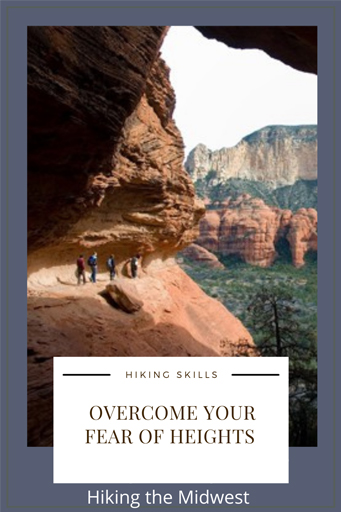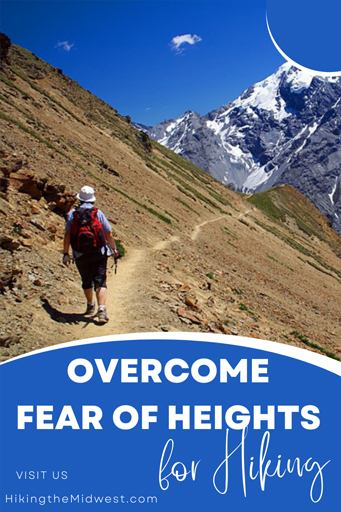There’s something about heights that just makes our heart race and palms sweat. Maybe it’s the sense of exposure or the fear of falling, but for many of us, heights are simply terrifying. Even if we wouldn’t necessarily classify ourselves as “afraid” of heights, most of us will avoid situations where height is a factor. But what if we could learn to conquer our fear? It turns out that there are some techniques that can help us overcome our fear of heights and live a more fearless life. Read on to find out how!

Table of Contents
What is Acrophobia?
Acrophobia is an extreme or irrational fear of heights. The fear of heights is not something that most people can fully understand. For those who suffer from acrophobia, the mere thought or sight of being above ground makes them feel extremely panic-stricken.
How Common is Acrophobia?
Acrophobia affects about 5% of the world’s population 4. With an approximately 8 billion world population, that’s about 400 million people affected by fear of heights. You’re far from alone if you suffer from this phobia.
What Causes Fear of Heights?
No one is 100% sure about the cause of acrophobia, but they have some ideas.
- It can stem from our natural instinct to stay safe and avoid a fall
- A traumatic experience with a fall from heights can lead to developing fear of heights
Newer research has also led to the belief that acrophobia is different from other phobias. Scientists now think that it could be caused by a non-associative pathway, instead of people learning about it from bad experiences5. Meaning it may possibly, in certain cases, be genetic.
What Happens When You Have a Fear of Heights?
Having a fear of heights causes a lot of variable symptoms. Though exactly how you experience a situation at height will be unique to you and your level of fear, the symptoms are pretty standard throughout the acrophobic crowd. Let’s talk about some of the things that happen when you’re afraid of heights.
Physical Symptoms
- Breathing rapidly
- Feeling dizzy, lightheaded, or faint
- Trembling
- Feeling nauseous
- Becoming paralyzed, or “stuck” sometimes called Jelly Legs
- Your palms may become sweaty, further making you feel as if you can’t get a good grip on anything for stability
Visual Disturbances
People feel dizzy when they are at a high place because their brain gets confused. The input it gets from the eyes at a height is different than the input it gets from the body when they are standing on the ground. People feel unsteady at heights because they have less visual feedback. When people lose their balance, they try to increase their sway to get back to stability. However, this often makes them even more unstable2.
At heights where you feel unsafe, a visual phenomenon can occur where your vision plays tricks on your brain. You develop a contrast between your field of vision and your eyes that can make the scene in front of you look scarier than it is3.
I’ve experienced this on a portion of trail with a cliff overlooking some water below. There was probably only 20 or so feet to go to get back to the safety of an unexposed section of trail but the more I looked at that stretch, the farther away it seemed. It quickly became a daunting thought, “How can I possibly get all the way over there?”
I had to sit down for a while and attempt to calm myself down. I decided to try to crawl the rest of the way, concentrating on my alternating hands moving slowly across the ground in front of me. Before I knew it, I was past the spot that had paralyzed me with fear.
Tips for Overcoming your Fear of Heights
Practice Somewhere Safe
Search for aerial parks in your area. They usually consist of rope courses in the trees. You’re safely attached to the course itself to prevent falls and accidents. This is a great place to practice controlling your fear. Practicing in a place you know is safe can help you get used to the feeling of being up high. Take your time and pay attention to your steps and balance. Remember to breathe. It’s all too easy to forget when you’re in a scary situation but taking deep breaths can help calm you.
Don’t get discouraged if you can’t complete the course the first time you try, or even the second or third time. It’s a process to overcome your fear of heights, and there’s no “normal” amount of time it takes.
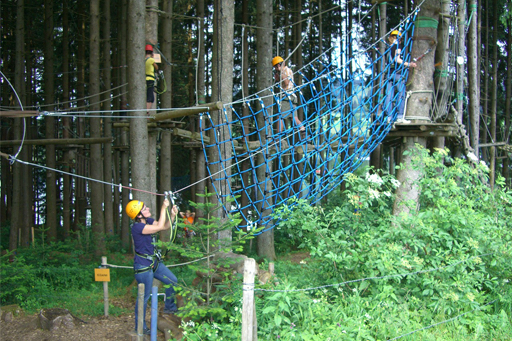
Visualize Your Success
If even the thought of traversing a ridge sends you into a panic, this tip can work especially well if you can find photos or VR video of the sections of trail that may give you trouble. Even if you don’t have access to these, or you don’t know exactly where you’ll be hiking yet, you can still visualize success.
Write down what you want to accomplish. The more specific the better. For example, “I will not stop my fear of heights from getting in my way of completing “insert your bucket list hike here”. Read this statement before you start the actual visualization process.
When you’re ready to start visualizing, close your eyes and picture yourself traversing a section of trail, real or imagined, that would give you difficulty in real life.
Remember to breathe through your visualization. If you struggle with your fear during the visualization, remind yourself that you’re in a safe place and that you can’t be hurt. After you successfully visualize yourself completing this, don’t forget to visualize yourself triumphant!
If you’re one of the people who struggle with picturing places that aren’t right in front of you, you can try watching a YouTube or VR video of a hiking trail that encounters heights. Walking in place as if you were on the trail can really help you picture yourself on the trail.
Create a Vision Board

Another way to help you visualize successfully overcoming your fear of heights is to create a vision board. You can make a digital board with a program like Canva (free), or a physical board using a sheet of posterboard.
Find photos of hikes you would love to accomplish one day but may be too afraid to attempt right now and create a collage of them. You can even add motivational quotes to your vision board.
Save your digital board as your desktop or phone background or hang your physical board on a wall you see throughout the day.
Cognitive Behavior Therapy (CBT)
Cognitive behavior therapy is where you work with a mental health professional to change your thought pattern. It focuses on turning negative thought patterns into a more positive though process.
It can help you learn to overcome your fear of heights by teaching you to recognize your negative and anxiety driven thoughts while in the situation and turn them into positive thoughts you can use to motivate and encourage yourself.
Crawl If You Have To
If you find yourself in a spot that’s causing you immense fear and you feel like you just can’t continue, try crawling. Being closer to the ground can help you feel more stable and secure.
This tip has gotten me past some scary-to-me sections of trail that I wouldn’t have been able to do if I hadn’t gotten down and crawled. Get down on all fours and stay put for a minute. Pay attention to how you feel and breathe. Notice if your symptoms start to recede or not. Is the feeling coming back to your jelly legs? Is your dizziness or nausea dissipating? Is your breathing returning to normal?
If your symptoms are improving now that you’re closer to the ground, try to take a few steps forward. (What is moving forward called when you’re crawling? Steps? Crawls?)
If you still feel ok after moving forward a bit, keep going. Go as slow as you need to and concentrate on your breathing and the ground in front of you. Before you know it, you’ll be past the scary part and feeling a sense of well-deserved accomplishment!
Tips for Overcoming Your Fear of Heights While Hiking
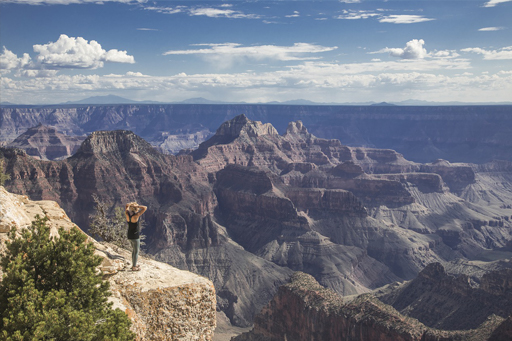
Research your Trail Well
Google all the trail information you can find. Look for trail reviews and articles from people who have already hiked it. Use AllTrails or your favorite trail apps to look at photos of as much as the trail as you can find.
This can help you find places along the trail that may make you uneasy and help you mentally prepare to encounter them when hiking day comes. It can also help you identify trails that may not be the right choice for you yet.
Hike with a friend
Preferably one who is a good motivator and can help talk you through any rough patches you might encounter.
Try Watching Videos of Heights
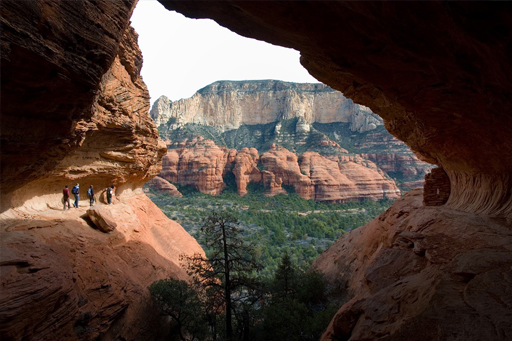
Studies performed since 1995 have shown that Virtual Reality Exposure Therapy (VRET) may be just as effective as real life experiences of heights1. If you have a VR device, try watching a video of heights on it.
- Here’s a pretty mild 360 VR of a hike in the mountains of Switzerland.
- A little bit more intense, this one is a hike through the Grand Canyon where you’ll virtually hike on a trail that has a steep drop on one side, and a canyon wall on the other.
- An intense VR hike of Angel’s Landing in Zion National Park. If you’re not familiar with this trail, it entails a steep hike across a narrow ridge, with steep drops on both sides.

Have Confidence in Your Gear
Being able to trust your gear can go a long way in helping you feel secure while hiking. So, if your trusty boots have shown you over and over that they have good traction on many surfaces, you can tell yourself to let go of the thought that they’ll slip.
Final Thoughts
If you want to hike the trails that take you high into the mountains or just be able to climb a ladder or look over a balcony, but fear of heights is keeping you from doing so, know that there are ways to overcome this fear.
Although it may be difficult, conquering your fear of heights is definitely doable. With time, practice, and patience, you can work up to climbing mountains or even just taking a walk on a high ledge. It’s important to remember that everyone experiences fear in different ways and at different levels; don’t compare yourself to others or put unnecessary pressure on yourself.
Just take things one step at a time and enjoy the journey along the way. Have you ever conquered your fear of heights? Tell us about it in the comments below!
Related Posts
Citations
1Coelho, Carlos M, et al. “The Use of Virtual Reality in Acrophobia Research and Treatment.” Journal of Anxiety Disorders, vol. 23, no. 5, June 2009, pp. 563–574.
2Coelho, Carlos M., and Guy Wallis. “Deconstructing Acrophobia: Physiological and Psychological Precursors to Developing a Fear of Heights.” Depression & Anxiety (1091-4269), vol. 27, no. 9, Sept. 2010, pp. 864–70. EBSCOhost, doi.org/10.1002/da.20698.
3Kapfhammer, Hans-Peter, et al. “Visual Height Intolerance and Acrophobia: Clinical Characteristics and Comorbidity Patterns.” European Archives of Psychiatry & Clinical Neuroscience, vol. 265, no. 5, Aug. 2015, pp. 375–85. EBSCOhost, doi.org/10.1007/s00406-014-0548-y
4,5 4 Misiewicz Z, Hiekkalinna T, Paunio T, Varilo T, Terwilliger JD, Partonen T, Hovatta I. A genome-wide screen for acrophobia susceptibility loci in a Finnish isolate. Sci Rep. 2016 Dec 20;6:39345. doi: 10.1038/srep39345. PMID: 27996024; PMCID: PMC5171840.
